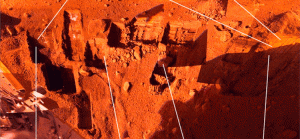NASA’s Phoenix spacecraft landed on the high northern plains of Mars. Among its instruments were optical and atomic-force microscopes. A team of scientists led by Tom Pike (Imperial College, London) used these to measure the size and number of particles in samples of Martian soil at the lander site. Such studies of a soil’s microstructure can reveal the processes that formed the soil, including any interactions with liquid water.

MARS DIRT has a different microstructure than Earth dirt, as explored by microscopic imaging by the Phoenix lander. This view shows several trenching sites studied. Besides the soil being dry for half a billion years, the scientists found that lunar soil makes a closer match in microstructure to Mars soil than Earth's does. (Image is taken from Figure 1 in the paper.)
The results, published in Geophysical Research Letters, suggest that the Phoenix soil has felt the touch of liquid water for, at most, no more than 5,000 years out of the last 600 million years. That’s the age of Heimdal Crater, whose ejecta blanket Phoenix landed upon.
“The Phoenix soil samples appear to originate from a well-mixed material typical of the Martian surface,” say the researchers. While ice lies just under the surface, the landing site is in an area of Mars where neither erosion nor deposition dominate, and the wind is the most important agent in moving soil particles.
To explore how long the soil has been dry, the scientists studied clay-size particles, those with diameters less than a few micrometers. Terrestrial soils have a distinctive signature from interactions with water: a sharp dropoff in the number of particles below 1 micrometer in size. Although microscope images revealed the Phoenix soil had such a falloff, it was at 10 micrometers, much too large to be explained by water-related clay formation.
Lead author Pike adds, “We confirmed that a copy of the flight hardware could identify this clay signature in our test samples on Earth. But there’s no sign of it in the Martian samples.” Experiments show that to get a soil with 6 percent phyllosilicate clays would take up to 400,000 years’ contact with liquid water to develop.
“As less than 0.05 percent of the Martian soil is of a size consistent with phyllosilicates,” the team says, “this implies the soil has seen at the very most a total of 5,000 years of liquid water in its history, and probably much less.”
The researchers conclude, “A globally homogenous soil with such a microstructure would be an unlikely habitat for the propagation of life on Mars.”








